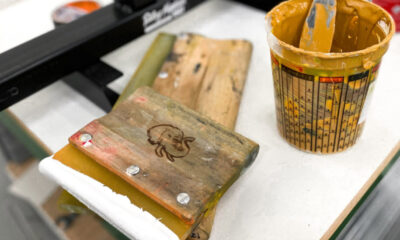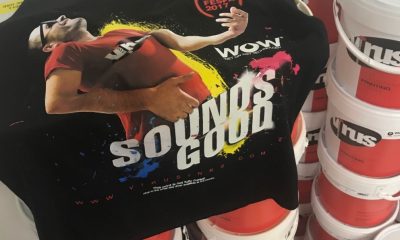Inks & Coatings
Published
21 years agoon
Polyvinyl chloride (PVC) is the key to many screen printers’ livelihoods. That compound is the primary component of plastisols used by most of the textile-printing industry. Greenpeace recently added PVC to its most wanted list and is calling for a ban of the product. So let’s have a look at the chemical conflict and discover how screen shops fit into the equation. Proper disposal is the primary concern with PVC because, when incinerated, it produces dioxins, which are harmful to the environment. Fortunately, PVC-containing plastisols used by garment screen printers are seldom incinerated.
Polyvinyl chloride (PVC) is the key to many screen printers’ livelihoods. That compound is the primary component of plastisols used by most of the textile-printing industry. Greenpeace recently added PVC to its most wanted list and is calling for a ban of the product. So let’s have a look at the chemical conflict and discover how screen shops fit into the equation. Proper disposal is the primary concern with PVC because, when incinerated, it produces dioxins, which are harmful to the environment. Fortunately, PVC-containing plastisols used by garment screen printers are seldom incinerated. They’re more likely disposed of in landfills as fully cured, 100%-solid plastics. The controversy with plastisol ink centers around unscrupulous print-shop owners who dump ink and ink sludge into the ground, as well as countries that lack resources to carefully handle such wastes. Plastisol packrats The burden is on shop owners to ensure that residual plastisols and ink sludge left from screen cleaning are properly handled after use. In most shops, inks are scraped out of screens at the end of a production cycle and returned to their containers for future use–it’s a way to maximize ink mileage. But sometimes production will call for a custom color, and frequently it’s just not worth keeping the miniscule amount of ink that is left in the screen after the run is complete. So the color is removed from the screen and placed into a scrap drum. The problem is that a high-volume facility can quickly fill a 55-gal drum with residual inks. In addition to this waste, most–if not all–garment shops keep an inventory of unwanted plastisols. Add to that the one- and five-gal containers that were purchased for special projects and never used, and you’re left with quite a stockpile of potentially hazardous materials. What’s the solution to plastisol stockpiling? In the US, a larger print shop often can work a deal with a plastisol manufacturer in which the manufacturer will absorb the shop’s residual inventory in exchange for a complete conversion to its ink systems. The manufacturer can rework the leftovers into an industrial compound or recycle the inventory into a printable product, such as a discount black ink. Disposal becomes a bit more challenging for companies that don’t have the clout to work out such deals with ink suppliers. Watching the waste Disposal of liquid plastisol is illegal in the US; therefore, it must be properly processed by either the original manufacturer or a recycling center. Disposing of liquid plastisols raises major concerns about their liquid components–plasticizers and reducers–leaching into the water table. These ink components are made from phthalates, a family of chemicals that are thought to pose health risks to humans and animals. Plastisols are deemed legal landfill once they are set into a solid form through fusion or curing. As the ink increases in temperature during the curing process, the powdered PVC resins in the inks begin to swell and absorb the liquid plasticizers. When the ink is cured at the proper temperature for the correct amount of time, the resin completely absorbs the plasticizers, leaving a solid-plastic film. This is, of course, assuming that the ink is in its original, unmodified state. If the product is modified beyond the recommended allowed percentage, the ink can possess an amount of plasticizers greater than the PVC can absorb. In that case, a licensed waste handler would have to be used to dispose of the end product. When a waste-management facility or ink manufacturer relieves you of plastisol waste, it similarly relieves you of the liabilities associated with disposal. (You should retain documentation of all related transactions in order to show that the proper authorities have assumed responsibility for processing the waste.) Keep in mind that ink sludge from screen cleaning should always be removed and processed by a licensed waste-disposal facility. Most large garment-printing operations use waste-disposal services that both deliver screen-cleaning chemicals and remove the used chemical/ink sludge solution at the end of its useful life. Services of this type will produce the appropriate paperwork to document the amount of hazardous waste a shop generates, when it is removed, and by whom. This type of documentation is a necessity–especially when OSHA pays a visit. Minimizing your waste inventory The custom ink-mixing systems available from most plastisol manufacturers include software that calculates the correct amount of ink needed for any job. These systems have done more for reducing the production of excess inks than any other measure to date. Before such systems were developed, it was commonplace for a printer to simply mix a half or full gallon of a specialty color and give no consideration to the disposal of any ink remaining once the production run was completed. Using a mixing system that gauges inks used for production runs is just one way to keep the waste to a minimum. Here are some other tips for remaining environmentally friendly with your plastisol usage: * Don’t mix more ink than you feel you’ll use. Remember, you have no guarantees that a customer will reorder a job until the order actually comes in. * Keep accurate documentation of every mixing formula. If your mixing system does not have software to do so, write the formula down and file it with the job jacket for future reference. * Use a waste-management service such as Saftey-Kleen, and have all excess waste materials removed and processed on a regular basis. * Do not allow excessive quantities of plastisol to build up in inventory. If you’re sure that you don’t need the ink, either have it reprocessed or sell it off to another screen printer. Although some plastisols start to show their age through viscosity changes after about six months, most remain printable for a much longer period of time. Making a living in screen printing and simultaneously exercising care for the environment can be a tough task. But by following the simple recommendations presented here, you can reduce your plastisol liabilities and ensure a safer world for future generations.

Subscribe

Magazine
Get the most important news
and business ideas from Screenprinting Magazine.
Most Popular
-

 Art, Ad, or Alchemy1 month ago
Art, Ad, or Alchemy1 month agoF&I Printing Is Everywhere!
-

 Case Studies1 month ago
Case Studies1 month agoHigh-Density Inks Help Specialty Printing Take Center Stage
-

 Andy MacDougall1 month ago
Andy MacDougall1 month agoFunctional and Industrial Printing is EVERYWHERE!
-

 Columns2 weeks ago
Columns2 weeks ago8 Marketing Mistakes Not to Make When Promoting Your Screen Printing Services Online
-

 Editor's Note2 weeks ago
Editor's Note2 weeks agoLivin’ the High Life
-

 Marshall Atkinson2 weeks ago
Marshall Atkinson2 weeks agoHow to Create a Winning Culture in Your Screen-Printing Business
-

 Thomas Trimingham2 months ago
Thomas Trimingham2 months ago“Magic” Marketing for Screen Printing Shops
-

 News & Trends1 month ago
News & Trends1 month agoWhat Are ZALPHAS and How Can You Serve Them in Your Print Business?





